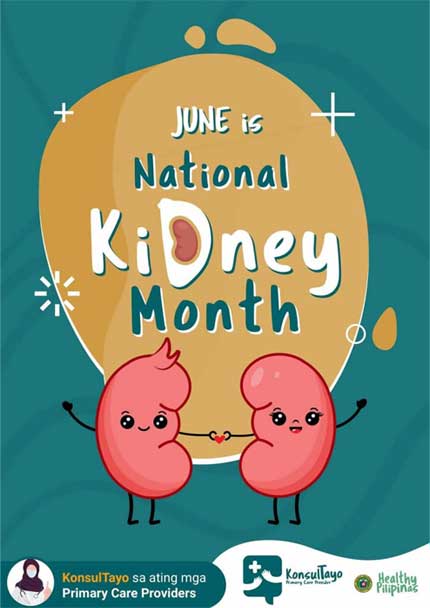
By Joseph Bernard A. Marzan
As the country observes National Kidney Month (NKM) this June, the public is reminded of the importance of kidney health to prevent Chronic Kidney Disease (CKD), a serious and often incurable condition.
According to the Washington State Institute of Health Metrics and Evaluation, CKD has been a leading cause of death in the Philippines, ranking No. 6 in 2009 and rising by 45% to rank No. 4 in 2019.
The National Kidney and Transplant Institute estimates that one Filipino develops CKD every hour, with up to 7 million Filipinos affected as of 2021.
Symptoms of CKD include fatigue, loss of appetite, swollen feet, frequent vomiting, low urine output, blood or proteins in urine, insomnia, shortness of breath, and sexual dysfunction.
Risk factors for CKD include family history, high blood sugar or pressure, heart conditions, obesity, smoking, and age over 60.
Even dialysis, a common treatment for renal diseases, does not easily cure CKD.
Dr. Rey Isidto, a nephrologist from the San Isidro Dialysis Center and president of the Western Visayas-Panay chapter of the Philippine Society of Nephrology (PSN), highlighted that CKD is often linked to lifestyle diseases like diabetes, hypertension, and gouty arthritis.
Other specific causes include kidney stones, chronic pyelonephritis (a type of urinary tract infection), glomerulonephritis (an autoimmune disease), and polycystic kidney disease.
Prolonged use of non-steroidal anti-inflammatory drugs (NSAIDs) can also lead to CKD.
CKD develops over at least three months, often without early symptoms.
Dr. Isidto emphasized that uncontrolled diabetes or hypertension can eventually damage the kidneys.
“I am not saying that when you develop diabetes [or] hypertension, your kidneys already have damage. But if you let your diabetes [or] hypertension go uncontrolled, eventually your kidneys will sustain further damages,” Isidto explained to the media last June 5.
Preventive measures include controlling blood pressure and sugar levels, eating a healthy diet (more vegetables, fruits, lean meats and fish, whole grain, and less sugar, sodium, and fat), regular exercise, adequate water intake, quitting smoking, and avoiding NSAIDs abuse.
Two key indicators for CKD are high serum creatinine levels and a low estimated glomerular filtration rate (eGFR).
The two determining factors that detect CKD are a high serum creatinine level and a low estimated glomerular filtration rate (eGFR).
The American Kidney Fund defines eGFR as “an estimated number based on a blood test and your age, sex, and body type”, while the GFR number is an indicator of kidney function.
The eGFR’s determination of kidney failure will come in 5 stages:
– Stage 1 with 90 or higher GFR (Damage with normal kidney function);
– Stage 2 with 89 to 60 GFR (Damage with mild loss of kidney function);
– Stage 3a with 59 to 45 GFR (Mild to moderate loss of kidney function);
– Stage 3b with 44 to 30 GFR (Moderate to severe loss of kidney function);
– Stage 4 with 29 to 25 GFR (Severe loss of kidney function); and
– Stage 5 with less than 15 GFR (Kidney failure).
“[W]hen creatinine rises, the blood is not being ‘cleaned’ as it should be, and [that means] that our kidneys are not functioning as usual. When the blood is being checked, the serum creatinine might rise, which is why it is not a joke when it rises. Even when you say that it might be little, the fact that the creatinine levels are higher than normal, it means that there is already kidney dysfunction,” Isidto said.
“When [the GFR] reaches Stage 5, that is already kidney failure. When you say kidney failure, you now need [to undergo] dialysis. So, the magic number here is 15. If the eGFR is less than 15, it means that kidney function is less than 15 percent. Anything below 15 percent, usually requires dialysis. We look into whether or not [the patient] would need dialysis,” he added.
Isidto emphasized that the kidneys not only filter waste but also regulate water levels and electrolytes, and produce erythropoietin, a hormone that stimulates blood production.
“The kidneys [are] a very silent but very effective organ in our body. First and foremost, they clean up the waste in our body. The most common that we know is creatinine, which is actually a by-product of cell metabolism. Other than that, they maintain the balance of water in our body, be it in the blood or in our urine,” he said.
Tests that confirm CKD include serum creatinine and urine albumin/creatinine ratio, fasting blood sugar, urinalysis, whole abdomen ultrasound, CT scan, and kidney biopsy.
Under the theme “Malusog na Bato, Abot-Kamay ng Bawat Pilipino,” the PSN, Department of Health, and other stakeholders are conducting awareness activities throughout the month.
Iloilo City’s two public dialysis centers are located in East Baluarte and San Isidro districts.




















